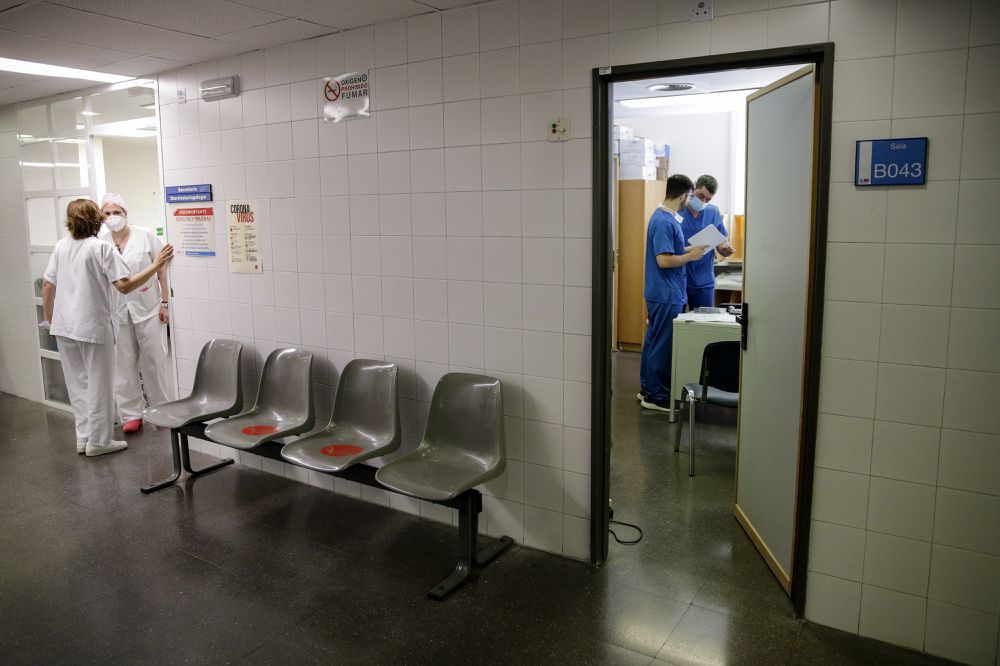The first wave of covid caused the almost total paralysis of the usual activity in the hospitals of Madrid, it touched all its areas: operating rooms that did not operate, test rooms that did not perform tests and closed consultations. In the community, between March and August, 1,979,323 of these visits to specialists were stopped. It was the successive ones – those that are used for the follow-up of patients with a pathology already diagnosed – those that most accused the initial shock of the pandemic, 1,105,635 were lost. Of the so-called first consultations, in which doctors see patients for the first time and are usually referred from primary care, 873,688 were those that could not be carried out.
The shielding that hospitals were subjected to as of mid-March to prevent the virus from continuing to circulate caused a panorama that they had never faced, of emptiness and silence, visits were prohibited, everything that was not urgent was stopped. : they did not have the resources, material or human, to face the pandemic and at the same time maintain ordinary assistance, and preventing further infections was essential. The urgent thing was to treat those infected with covid and relieve as soon as possible a care pressure that pushed the structure to the limit. Hospitals reached their peak in hospital admissions on April 2, with 16,174 patients; three days later, that peak reached the ICUs, with 1,520 critics, by then they were working at 291% of their original capacity.
Where were the rest of the patients, the strokes, the heart attacks, the chronic ones or the multipathological patients who had to be followed up? Although there is no breakdown by specialties, all were affected. Only in surgeries, 93,001 stopped being practiced between March and August, according to the data provided by the Community to the deputy and head of Health of Más Madrid in the Mónica García Assembly with the figures by hospitals of interventions carried out from March to August 2019 and 2020. The same happened with the first and subsequent queries, also included in this breakdown of numbers.
Madrid hospitals stopped practicing 93,001 operations between March and August
–Nine months later, García, an anesthesiologist on October 12, continues to wonder where they are and how all those patients are going to recover. The Community alleges that the reactivation is within the “elasticity plans” of the hospitals, protocols that include the necessary restructuring in the face of successive waves and, in principle, also the procedure to return to routine care. However, the virus has not yet given room for that return to occur.
The last week, moreover, the data reflects a rebound that the Minister of Health, Enrique Ruiz Escudero, has recognized as “mild” although, he said yesterday in an interview on Telecinco, it has not had “repercussion” at the healthcare level. Last week, he explained in reference to the bridge, assistance to health centers was concentrated “in three days”, something that may be due to the increase in the accumulated incidence, which this Monday stood at 227 cases per 100,000 inhabitants in the last 14 days; on Friday, the last day of the week that the Ministry of Health offers data, it was at 207.
In any case, although minimal, this rising figure is not positive for the care capacity of the centers, which have already accumulated nine months of pressure due to the covid. Mónica García points out that “all specialties have chronic pathologies that in some way could have been neglected” and that, “in addition, everything mild can be exacerbated”. A collapsed system, he says, means “that you do not have access to health protection, and an indispensable part such as prevention, that of getting things done on time, cannot be done.” The paralysis of those consultations that did not fall within the urgent, “will cause, predictably, a boomerang effect of very past and very chronic pathologies, the mild will have worsened”, he adds.
In this, García explains, the collapse of primary care had a lot to do with it: “Around 70-80% of the first consultations come from family doctors, but health centers were also blocked.” Nevertheless, the waiting list for first consultations has been reduced by 177,382 people since the beginning of the pandemic, in February there were 453,117 patients waiting, in October (last month with available data) there are 275,735. How? By the sum of those who did not attend for fear of the situation during the spring and those who were postponed or not called for not urging.
April: the critical month
The month in which it occurred most critically was April. So, hospitals did 45.9% of their usual activity in consultations when compared to the previous year – 1,138,937 in 2019 compared to 523,132 this year. May was the second, with 525,010 less; and in third place in March, when 375,092 were lost. As of June, the activity was recovering, although in August, a month in which the hospitals, for vacations, work at half gas, the consequences left by the covid were still dragging and the second wave had arrived, they were made 97,989 less than the previous year (671,850 in 2019 and 573,861 this 2020). Although this did not occur homogeneously in all centers.
In absolute numbers, the big eight (the so-called group 3) were mostly those who lost the most. With the exception of La Princesa and Puerta de Hierro —with 48,662 and 37,606 fewer visits to specialties, respectively— the rest heads the top of the list for missed visits: the San Carlos Clinic, 238,832, the Gregorio Marañón, 221,733, the 12 de Octubre, 199,292, Ramón y Cajal, 186,464, Fundación Jiménez Díaz, 135,755 and La Paz, 94,900.
In this last center, the second in size in the community after Marañón and which has the largest health staff (7,397 payrolls), an anesthetist thus synthesized the situation in which they found themselves on April 6: “We fight every day with what Let him come, we don’t think about tomorrow, the day you are on is always the most important ”. Even so, with no margin to organize anything beyond the next shift, if the percentage decrease is observed, La Paz was not one of those that suffered the most from the paralysis of routines by the virus.
Half gas assistance
The ones that lost the most, in percentage terms, were the Guadarrama hospital, which went from 576 in 2019 to 43 in 2020, 92.5% less; and Dr. Rodríguez Lafora, who went from 1,021 last year to 82 this year, 92% less. However, they are not representative of the context of the rest, since they are specialized centers without comprehensive care: Guadarrama is a mid-stay center specialized in the care and care of people in need of rehabilitation and care and Lafora treats patients who require psychiatric hospitalization brief, long-term psychiatric care or addictive disorders related to alcohol and other substances of abuse.
Of the rest, taking into account the eight referral hospitals, four remain among the 10 hospitals that stopped making the most consultations: the San Carlos Clinic, with 57.8% less, the Marañón, with 46.8%, the October 12, with 42.1%, and Ramón y Cajal, with 37.3%. In addition to Santa Cristina, with a loss of 49% of consultations, as well as Henares (48.9%), the Red Cross (39.8%) and Getafe (36.2%).
Health and its social determinants
That the Gregorio Marañón, on October 12 or the Getafe hospital are among those that suffered the most from the paralysis of their routine activity due to pendamia “is not by chance,” ´ says Mónica García, deputy and spokesperson for Health of Más Madrid in the Assembly. “It is related to the population they cover, those who serve areas with worse socioeconomic conditions, with more incidence of the virus, lost more.” García, anesthesiologist on October 12, refers to his center: “Who do we serve? To the population of Usera, Carabanchel, Villaverde Very affected by the virus ”.
Others, such as the Jiménez Díaz Foundation or Puerta de Hierro, held out better. “Because of the social determinants of the health of the citizens that they have to attend to,” García deepens. A population generally with access to better housing conditions, jobs with more flexibility for teleworking and more economic capacity to take prevention and protection measures against the virus, as well as isolation in the event of an infection. “Where and how you live matters when it comes to coping with a pandemic like this,” sums up the anesthesiologist.
Information about the coronavirus
– Here you can follow the last hour on the evolution of the pandemic
– Restrictions search engine: What can I do in my municipality?
– This is how the coronavirus curve evolves in the world
– Download the tracking application for Spain
– Guide to action against the disease
–


